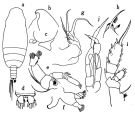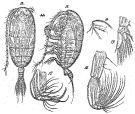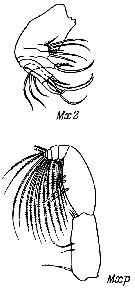|
|
 |
Fiche d'espèce de Copépode |
|
|
Calanoida ( Ordre ) |
|
|
|
Clausocalanoidea ( Superfamille ) |
|
|
|
Aetideidae ( Famille ) |
|
|
|
Chiridiella ( Genre ) |
|
|
| |
Chiridiella brachydactyla Sars, 1907 (F,?M) | |
| | | | | | | Syn.: | no Chiridiella brachydactyla : Grice & Hülsemann, 1965 (p.223, 231, figs.F) | | | | Ref.: | | | Sars, 1907 (p.9, Descr.F); 1925 (p.52, figs.F); ? Tanaka, 1957 a (p.58, Descr.M, figs.M); Markhaseva, 1996 (p.92, figs.F); Chihara & Murano, 1997 (p.683, Pl.33: F); Vives & Shmeleva, 2007 (p.557, Rem.F,M) |  issued from : O. Tanaka in Publ. Seto Mar. Biol. Lab., 1957, VI (1). [p.59, Fig.36]. With doubt. Male: a, habitus (dorsal); b, forehead (lateral); c, last thoracic segment (lateral left side); d, anal segment and furca (dorsal); e, A2; f, Md; g, Mx2; h, distal margin of 1st basal segment of Mxp; i, P2; j, P5. Nota: Head and 1st thoracic segment fused, 4th and 5th fused. Lateral corners of last thoracic segment rounded. Proportional lengths of urosomites and furca 27:21:15:18:6:15 = 100. A1 (24-segmented) exceeds distal margin of furca by terminal 2 segments. 1st basal segment of A2 has a tuft
of hairs. Md: biting part thin-skined. Mx1: outer lobe with 5 long setae, exopod with 10 setae, endopod and inner lobes reduced. Mx2 reduced, 4th and 5th lobes are large, each with a strong spine at the apex. 5th lobe of first basal segment of Mxp has a peculiar spine folked at the apex.
|
 Issued from: G.O. Sars in Résult. Camp. Scient. Prince Albert I, 69, pls.1-127 (1924). [Pl.XVI, figs. 12-17]. Female: 12, habitus (dorsal); 13, idem (lateral left side); 14, forehead (lateral); 15, Mx2; 16, Mxp; 17, P4.
|
 Issued from : E.L. in Proc. Zool; Inst. RAN, 1996, 268. [p.93, Fig.68]. After Sars, 1924. Female: Mx2 and Mxp.
|
 Chiridiella brachydactyla Chiridiella brachydactyla female: 1 - Mx2 with 5 endites. 2 - Mx2 not strongly modified in comparison with typical. Setation first-fifth endites are nearly of the same size, without pincers-like spines. 3 - Endopod of P1 without external lobe. 4 - Exopod of P1 with 1 external spine. 5 - Mx2 first-second endites with 3 setae each.
|
 Chiridiella brachydactyla Chiridiella brachydactyla female ; 1 - Mx2 lobes without spines arranged as pincers. 2 - 4th and 5th lobes of Mx2 with enlarged hooklike spines. 3 - P1 exopod with 1 edge spine. 4 - Mx2 without fan of spinules on lobes 1-4.
| | | | | NZ: | 1 + 1 douteuse | | |
|
Carte de distribution de Chiridiella brachydactyla par zones géographiques
|
| | | | Loc: | | | N Atlant. (Azores), ? Japan (Sagami) | | | | N: | 2 | | | | Lg.: | | | (1) F: 3,5; ? (39) M: 2,36; {F: 3,50; ? M: 2,36} | | | | Rem.: | Bathypélagique. Le specimen du Japon (Sagami) prélevé dans un trait vertical de 1000-0 m.
Cette espèce n'est connue que par une femelle et un mâle décrits séparèment et avec une distribution géographique tout à fait étonnante. Pour Bradford (1971 b, p.21) l’attribution du mâle à cette espèce n’est pas évidente. Ce cas, bien que très rare, n'est cependant pas unique (cf. Xanthocalanus echinatus). Markhaseva (1996) ne tient pas compte de l’identité du mâle avec la forme femelle décrite par Sars. | | | Dernière mise à jour : 26/07/2018 | |
|
|
 Toute utilisation de ce site pour une publication sera mentionnée avec la référence suivante : Toute utilisation de ce site pour une publication sera mentionnée avec la référence suivante :
Razouls C., Desreumaux N., Kouwenberg J. et de Bovée F., 2005-2025. - Biodiversité des Copépodes planctoniques marins (morphologie, répartition géographique et données biologiques). Sorbonne Université, CNRS. Disponible sur http://copepodes.obs-banyuls.fr [Accédé le 30 novembre 2025] © copyright 2005-2025 Sorbonne Université, CNRS
|
|
 |
 |






